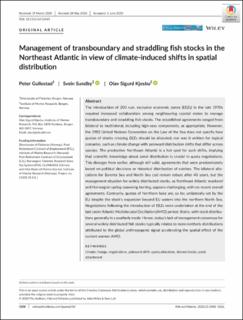| dc.description.abstract | The introduction of 200 n.m. exclusive economic zones (EEZs) in the late 1970s required increased collaboration among neighbouring coastal states to manage transboundary and straddling fish stocks. The established agreements ranged from bilateral to multilateral, including high‐seas components, as appropriate. However, the 1982 United Nations Convention on the Law of the Sea does not specify how quotas of stocks crossing EEZs should be allocated, nor was it written for topical scenarios, such as climate change with poleward distribution shifts that differ across species. The productive Northeast Atlantic is a hot spot for such shifts, implying that scientific knowledge about zonal distribution is crucial in quota negotiations. This diverges from earlier, although still valid, agreements that were predominately based on political decisions or historical distribution of catches. The bilateral allocations for Barents Sea and North Sea cod remain robust after 40 years, but the management situation for widely distributed stocks, as Northeast Atlantic mackerel and Norwegian spring‐spawning herring, appears challenging, with no recent overall agreements. Contrarily, quotas of Northern hake are, so far, unilaterally set by the EU despite the stock's expansion beyond EU waters into the northern North Sea. Negotiations following the introduction of EEZs were undertaken at the end of the last cooler Atlantic Multidecadal Oscillation (AMO) period, that is, with stock distributions generally in a southerly mode. Hence, today's lack of management consensus for several widely distributed fish stocks typically relates to more northerly distributions attributed to the global anthropogenic signal accelerating the spatial effect of the current warmer AMO. | en_US |
